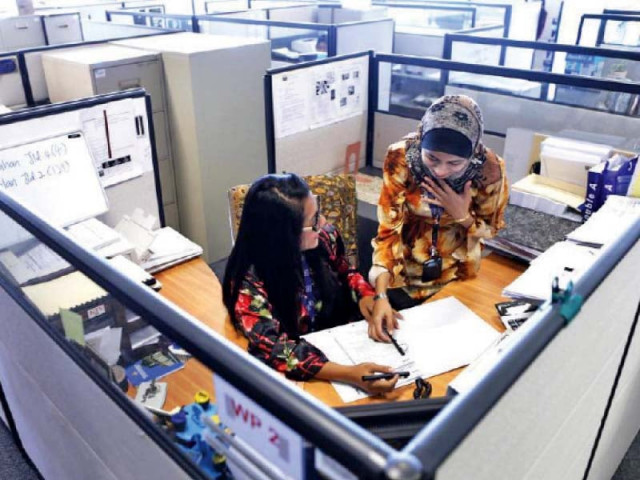Promoting women-driven SMEs
Most banks fail to reach out to microenterprises run by women, offer credit facility

In August 2017, the State Bank of Pakistan (SBP) introduced a refinance and credit guarantee scheme for women entrepreneurs.
The purpose was to enable women entrepreneurs to do more and do better in their respective fields of small business. The purpose also was to encourage more women to become entrepreneurs and initiate their own business.
At that time, the SBP had fixed the refinance and credit guarantee limit at Rs1.5 million for each eligible woman entrepreneur. Three years later, in August 2020, the central bank raised the limit to Rs5 million.
A refinance scheme works like this. The central bank encourages commercial banks to lend to a particular segment of borrowers at below-market interest rates because it believes lending to that sector is necessary for the benefit to the economy.
In a credit guarantee scheme, commercial banks are reassured that their potential losses in extending loans to the targeted borrowers will be compensated to a large extent by the central bank. In case of the credit guarantee scheme for women entrepreneurs, the central bank provides 60% risk coverage to the banks that lend to them. This refinance and credit guarantee scheme has its own merits. But more needs to be done to promote the culture of entrepreneurship among women and promote women-driven small and medium enterprises (SMEs).
While offering financial support to women entrepreneurs under the refinance and credit guarantee scheme, banks are currently focusing mostly on what is referred to as growth/ opportunity entrepreneurs.
The World Bank defines this class of entrepreneurs as the ones who aspire to create a large, vibrant business that grows far beyond the scope of their subsistence needs and provides jobs for others. Examples of such women-driven enterprises include SMEs of branded clothing, shoes and self-care/ beauty products.
Banks are also providing financial support to women-driven beauty parlours, clinics and medical centres, online food shops, etc – mostly in big cities like Karachi and Lahore.
Subsistence entrepreneurs
But there is another class of women entrepreneurs – much larger in size than the one mentioned above – that get very little attention of banks in urban areas. They fall in the category that the World Bank labels as necessity/ subsistence entrepreneurs.
These entrepreneurs, as the name suggests, are the ones that engage in entrepreneurial activity to provide subsistence income to themselves and their close families. In Korangi, Keamari, North Karachi, New Karachi, Orangi and Surjani neighbourhoods of Karachi, thousands of women are running microenterprises to support just themselves and their families.
They bake breads, prepare pickles and jams, sell cooked food, clean and cut fish, run tuition centres and mini-beauty parlours, sew clothes and even make shoes. Most banks never bother to reach out to them, assess their financial needs and offer them credit facility, either individually or through cluster formations. A few microfinance banks that claim they do it end up lending to growth/ opportunity women entrepreneurs.
In rural areas of Pakistan, microfinance institutions (MFIs) have long been catering to both necessity/ subsistence and growth/ opportunity categories of women entrepreneurs. And, their lending has undoubtedly made a difference in the lives of rural womenfolk. But that said, the potential for such lending is being exploited a bit slowly. In August last year, the central bank asked all the banks participating in the refinance and credit guarantee scheme to ensure the processing of loan applications of women within 30 days, which is a laudable move. The central bank also instructed them to ensure that 20% of the total volume of earmarked funds under the refinance and credit guarantee scheme is lent to women in Balochistan. That also is a laudable move.
But issuing instructions to banks is not enough. Ensuring compliance in true letter and spirit is everything.
Financing trend
According to the SBP, the stock of SME financing fell from Rs422 billion in September 2019 to Rs386 billion in September 2020. (This trend must have been reversed by now due to lending to SMEs from October 2020 onwards as part of concessionary financing under the Covid-related fiscal and monetary package).
One hopes that while reporting data in future, the SBP would inform the nation how much money is lent to women-driven SMEs. It was being projected since 2015 that the number of women borrowers of all types, including those seeking enterprise loans from banks, would shoot up from 2 million in 2015 to 4.6 million in 2020. According to the Pakistan Microfinance Network (PMN), the number of active women borrowers from microfinance institutions gradually increased from 2 million in 2015 to 3.8 million in 2019.
But given the sorry state of affairs of the entire SME sector, it is too much to expect that women-driven SMEs are being financed generously. Part of the problem lies on the demand side.
Demand for official financing originating from women-driven SMEs cannot be expected to increase. Businesses owned by women are often registered in the name of male family members, more frequently in rural areas, but also in big cities.
The writer is an electronic engineer and pursuing masters
Published in The Express Tribune, March 8th, 2021.
Like Business on Facebook, follow @TribuneBiz on Twitter to stay informed and join in the conversation.



















COMMENTS
Comments are moderated and generally will be posted if they are on-topic and not abusive.
For more information, please see our Comments FAQ